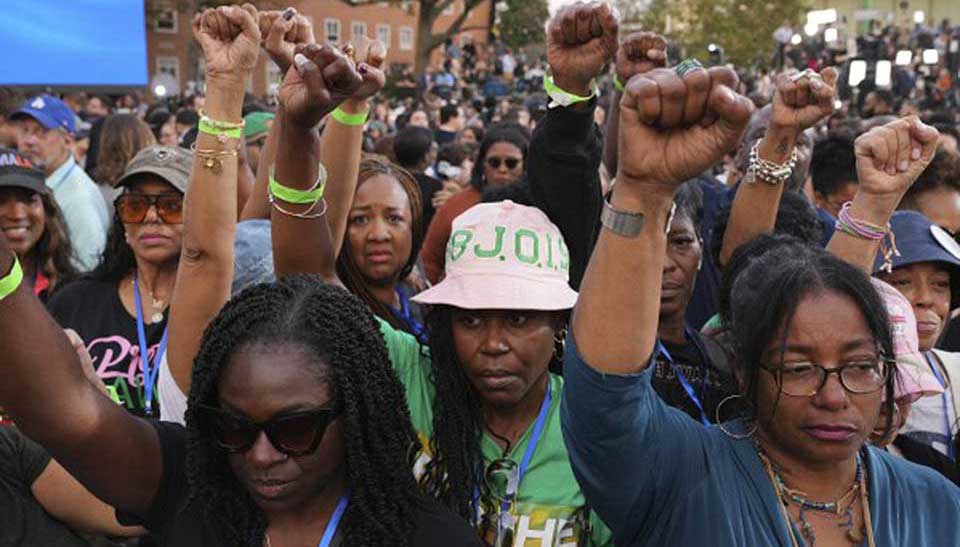
WASHINGTON—In time-honored fashion—unlike what occurred under then-President Trump almost four years ago—Vice President Kamala Harris, the Democratic presidential nominee, conceded this year’s election. Both on stage and in a phone call, she reminded the convicted felon who will take over in January that the norm in the U.S. is a peaceful transition of power.
Harris used that November 6 concession, and reminder, to tell the crowd at her alma mater, Howard University, the historically Black university in D.C., that democracy is still worth fighting for, even when there are setbacks.
The difference “between a democracy and an autocracy,” Harris said, is that we owe our loyalty not to one person but to our democracy, to our Constitution, and to our God.
“I do not consider the fight that fueled this campaign” or “the ideals that reflect America at its best” to be over. Every American has fundamental freedoms that must be upheld,” she declared. “We will uphold this in the courthouse and in the public square,” said Harris, a former San Francisco DA and state Attorney General. “The light of America’s promise will always burn bright, as long as we keep fighting and never give up.” And she challenged the young people in the crowd to keep the fight going.
Harris said the fundamental freedoms include a woman’s freedom “to make decisions about her own body,” the line she used throughout her drive to refer to reproductive rights. The three Trump-named U.S. Supreme Court justices formed the core of the five-justice Republican court majority which trashed that nationwide right two years ago. “I will not give up the fight” for abortion rights, she said.
That fight will be a difficult one, but it would be easier if the Republicans do not win control of the House in addition to their already-won control of the presidency and the U.S. Senate. Mike Johnson, the current Republican Speaker of the House, says his party will prevail in the yet undecided fight for control but, after just a year on the job, he has had difficulty governing and in the new Congress it would be no different. Hard-liners led by Rep. Marjorie Taylor Greene, Rep. Matt Gaetz, and others have often confronted and upended their own GOP leadership in what has been one of the most chaotic sessions in modern times.
If Johnson’s slim four-seat majority were to shrink any further, governing could come to a standstill. Democratic Minority Leader Hakeem Jeffries said the House “remains very much in play.”
With Democrats having defeated two House Republicans in Jeffries’ home state of New York, he said the path to the majority now runs through pickup opportunities in Arizona, Oregon, Iowa, and California that are still too early to call. “We must count every vote,” Jeffries said.
The House contests remained a tit-for-tat fight to the finish, with no dominant pathway to the majority for either party. Rarely, if ever, have the two chambers of Congress flipped in opposite directions.
Each side is gaining and losing a few seats, including through the redistricting process, which is the routine redrawing of House seat boundary lines. Often that process involves lawmakers picking their voters rather than voters selecting their lawmakers. The process reset seats in North Carolina, Louisiana, and Alabama.
Much of the outcome hinges on the West, particularly in California, where a handful of House seats are being fiercely contested, and mail-in ballots arriving a week after the election will still be counted. Hard-fought races around the “blue dot” in Omaha, Nebraska, and in far-flung Alaska are among those being watched.
Although Trump won the presidency there were victories for a variety of progressive ballot measures Ironically, pro-abortion measures, including constitutional amendments, won majorities in seven of the ten states where they were on that ballot. They will be law in only six of them. Florida’s rabidly right-wing Republican government imposed a “supermajority” requirement for the citizen-proposed constitutional amendment there to pass muster. It didn’t.
In an understatement, after thanking her family, staff, volunteers, and her boss, Democratic President Joe Biden, Harris admitted the election’s “outcome is not what we wanted, not what we worked for and not what we voted for.”
Though she did not say so, the “outcome” also includes the loss of the narrow pro-worker Senate Democratic majority and the defeat of one of its most consistent and effective pro-worker advocates, Sen. Sherrod Brown, D-Ohio. Working with labor’s legislative representatives, Brown assembled a compromise—overturning a prior Republican pension cut—that saved financially troubled multi-employer pension plans, among other achievements.
Proud of her campaign
Harris said she was proud of her 107-day presidential campaign after she replaced Biden at the top of the ticket. Biden dropped out after savage intra-party criticism of his debate performance against Trump late in the primary season. Panicked Democratic biggivers and lawmakers forced him out. Her campaign, the vice president said, “was animated by love and joyous enthusiasm for the future.”
Harris did not go into why she lost the presidency to Trump, a convicted felon, serial misogynist, congenital liar, and six-time bankrupt. Others in and outside the Democratic Party are undertaking that, among them Vermont’s independent Senator, Bernie Sanders. Sanders, who strongly backed Harris in her campaign and criticized Trump as a dangerous fascist, had strong criticism, however, for what he said was the role of the Democratic Party in the Harris defeat.
Sanders, the current chair of the Senate Labor Committee, coasted to re-election in Vermont. But he said, in speeches and videos that Democrats—Harris included—did not offer enough of an appeal to working-class voters, did not offer solutions to their economic ills, and did not attack the millionaire corporate class and how it rigs the government.
As a result, the loss of the Senate majority means Sanders, who ranks ahead of all senators, including Ohioan Brown, as an advocate for workers, must yield the committee chair to a labor hater, likely to be rabidly anti-worker Sen. Bill Cassidy, R-La.
Sanders’s criticism of the Democratic Party goes back to what he sees as party failures that have their origins long before Vice President Harris came on the scene.
“It should come as no surprise that a Democratic Party which has abandoned the working class that the working class has abandoned them. First, it was the white working class, and now it is Latino and Black workers as well. While the Democratic leadership defends the status quo, the American people are angry and want change. And they are right.
“Today, while the rich are doing phenomenally well, 60 percent of Americans live paycheck to paycheck and we have more income and wealth inequality than ever before. It is unbelievable that inflation-adjusted weekly wages for the average American are now the same as were wages for people 50 years ago.”
Trump, the beneficiary of worker anger, has, of course, no plans to alleviate the suffering of the working class in the United States. His plans will, if anything, will worsen their living situation. As usual in U.S. history, it will be up to workers and their allies to lead the fight to improve their own conditions. The recent upsurge in activity by the labor movement, exemplified by the UAW’s Stand Up strikes against the auto giants and the massive unionization drives underway coast to coast, can be expected to be a major part of this movement as Trump pushes for his billionaire pals.
Harris offered specific measures, such as reinstating the expanded child care tax credit or tackling corporate price gouging but left many basic working-class issues to the labor movement to raise.
Trump included in some of his chaotic speeches, calls for solutions to economic problems like tax cuts. His cuts will be mostly additional ones for the wealthy. He did not, of course, mention that on the campaign trail nor did he mention how his calls for more deregulation of corporations will result in further destruction of worker rights.
Another factor Harris did not mention was popular opposition to war including the ongoing arming of both Ukraine and Israel. Israel is waging a savage war on Gaza, which its rightist Prime Minister, Benjamin Netanyahu, has now extended to Southern Lebanon. The U.S. has sent billions to Ukraine where it is waging a proxy war against Russia. Trump, who is anything but a peace candidate, exploited that situation to claim that he will bring peace.
Some 43,000 Gazans and 3,000 Lebanese have been killed, all with U.S.-bought arms, planes, ammo, and one-ton bombs. Gaza is now a smoking ruin, with two million refugees, many starving, disease-ridden, or both.
The war on Gaza split the Democratic Party and cost it votes among both younger voters and Muslim-Americans, a key voting bloc in several swing states, led by Michigan and Pennsylvania, Muslim-American groups say.











